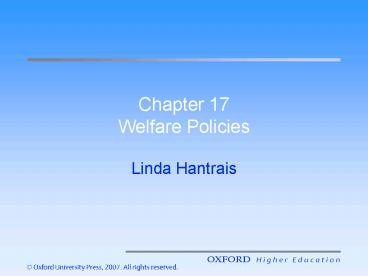Chapter 17 Welfare Policies PowerPoint PPT Presentation
1 / 10
Title: Chapter 17 Welfare Policies
1
Chapter 17Welfare Policies
- Linda Hantrais
2
Welfare Policies
- Why study European welfare policies?
- Conceptualising, theorising and measuring welfare
- Differentiating national social welfare systems
- Developing European social welfare competence and
legitimacy - European integration, globalisation and welfare
convergence
3
Why study European welfare policies?
- Lens through which to examine European
integration - Key to understanding economic policy
- Part of wider relationship between national
welfare systems and wider processes of European
integration/globalization
4
Conceptualising Welfare
- Social welfare refers to collective provision of
resources to protect against risk/need and to
improve living standards - The state is key in delivering these resources
- Inter-related with economic system
5
Theorising Welfare
- Social democratic perspectives emphasize
universality of needs - Neo-liberals promote minimal provisions
- Third way looks for alternatives to state welfare
- Feminists argue that welfare is gendered to the
disadvantage of women
6
Measuring Welfare
- Nationally-specific measurements make
cross-national comparisons difficult - On average, 25 of GDP in EU15
- Welfare funded differently in different countries
- Impact of welfare systems also varies across
countries
7
Differentiating national welfare systems
- Differentiated in terms of decommodification
(Esping-Andersen) - Social democratic welfare regimes
- Conservative/corporatist welfare regimes
- Liberal welfare regimes
- Southern European and Eastern European member
states struggle to fit into this scheme
8
EU welfare systems
- Original 6 member states corporatist welfare
regimes - 1970s and 1990s enlargement has shifted the EU
towards social democratic welfare regime - However, UK has moved towards liberal regime
- Southern European welfare states rely heavily on
self-provision by family members - 2004 CEECs have adopted a hybrid system
9
Developing social welfare competence and
legitimacy
- EEC social policy originally intended to support
common market - By 1990s, social policy gaining greater
legitimacy, but still as support for economic
integration - UK vetoed social policy chapter in Maastricht
Treaty - Governments have moved to a softer approach to
social policy, esp. OMC
10
European integration, globalization and welfare
convergence
- Economic integration has not reduced path
dependent diversity between states - Social integration is becoming more necessary, so
preventing race to the bottom - National policies/institutions mediate common
pressures, producing divergent outcomes - National diversity remains in place

